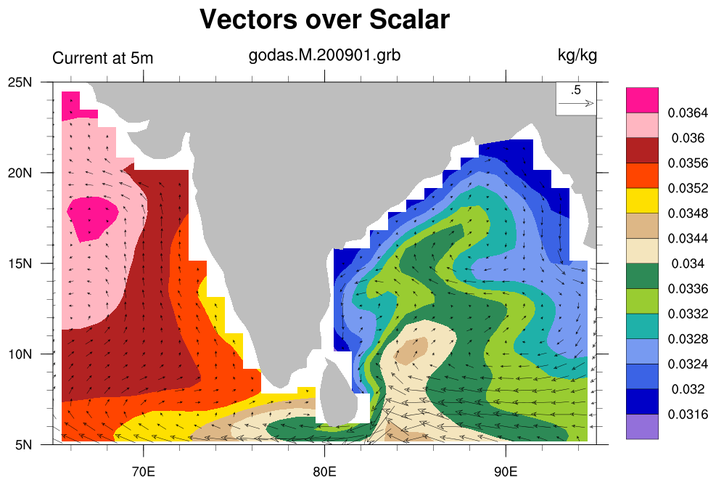NCL Home>
Application examples>
Data sets ||
Data files for some examples
Example pages containing:
tips |
resources |
functions/procedures
GODAS: Global Ocean Data Analysis System

The NCEP
Global Ocean Data Assimilation System (GODAS) uses
continuous real-time data from the Global Ocean Observing System.
This project is to deliver routine ocean monitoring products,
and is being implemented by the Climate Prediction Center in
cooperation with NOAA's Office of Climate Observation (OCO).
Data Availability
GRIB-1: Monthly and pentad data can be downloaded
by clicking on the Binary Data link at the
GODAS website.
netCDF: GODAS data can be downloaded from the NOAA/OAR/ESRL
Physical Sciences Division (PSD),
Boulder, Colorado, USA, from their Web site at
http://www.cdc.noaa.gov/data/gridded/data.godas.html.
The data adhere to the
COARDS
netCDF convention.
The data files contain one variable for each year.
One peculiarity with the PSD GODAS files is that they include
missing_value and _FillValue attributes that are
different (Click here for an example.).
NCL only recognizes _FillValue. Hence, the
user must make some changes. See Example 4.
NCL Comments
The golden rule of 'data processing' is to look at the data prior to processing.
The command line utility,
ncl_filedump,
can be used to examine a file's contents. It readily accepts files
in a variety of formats including GRIB and netCDF. Sample results from use
on a GODAS GRIB file and a NOAA/OAR/ESRL/PSD netCDF file:
ncl_filedump -itime godas.M.200901.grb
ncl_filedump thflx.2008.nc
The output from
ncl_filedump
on the GRIB can be seen here
and on the netCDF file can be seen here.
The GRIB file has all the variables for a particular year-month while
the netCDF has one variable for each month of the year.
NCL can import the data directly. NCL does not care which format is input:
- NCL will unpack the GRIB directly.
- The netCDF files provided by NOAA/OAR/ESRL/PSD
contain variables of type "short". The NCL function
short2flt can be used to unpack the values
and retain all meta data.
NCL's coordinate subscripting is used in several of the examples.
This allows the use of 'physical coordinates' to access subsets of the data.
This is more convenient then using subscript indices.


 godas_1.ncl
godas_1.ncl:
Read a GODAS
grib formatted file and create a
standard cylindrical equidistant plot. In addition, create
two cross-section views: default and raster.


 godas_2.ncl
godas_2.ncl:
Read a GODAS
grib formatted file and plot vectors over a scalar [here, salinity].
A standard cylindrical equidistant plot and two regional plots. The last
plot required the
lonFlip
function be used to shift from 0-to-360 to -180 to 180.

 godas_3.ncl
godas_3.ncl:
Read a variable (here,
pottmp at a depth of 5 meters) spanning thirty GODAS
netCDF files for the period 1980 to 2009;
calculate a monthly climatology for 1995-2004; calculate
anomalies and create a regional time series of anomalies
over a specific region.
 godas_4.ncl
godas_4.ncl:
Read from PSD netCDF files. Manually force the NCL recognixed _FillValue
attribute to take on the value of the missing_value attribute. then
'unpack' the short values to float. Create a panel plot.









